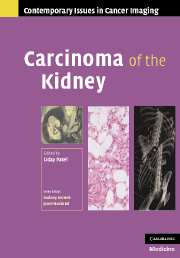Book contents
- Frontmatter
- Contents
- Contributors
- Series foreword
- Preface to Carcinoma of the Kidney
- 1 Renal cell cancer: overview and immunochemotherapy
- 2 Pathology of adult renal parenchymal cancers
- 3 Familial and inherited renal cancers
- 4 Radiological diagnosis of renal cancer
- 5 Staging of renal cancer
- 6 The case for biopsy in the modern management of renal cancer
- 7 Imaging characteristics of unusual renal cancers
- 8 Surgery for renal cancer: current status
- 9 Ablation of renal cancer
- 10 Post-treatment surveillance of renal cancer
- 11 Imaging for nephron-sparing procedures
- Index
- Plate Section
- References
4 - Radiological diagnosis of renal cancer
Published online by Cambridge University Press: 08 August 2009
- Frontmatter
- Contents
- Contributors
- Series foreword
- Preface to Carcinoma of the Kidney
- 1 Renal cell cancer: overview and immunochemotherapy
- 2 Pathology of adult renal parenchymal cancers
- 3 Familial and inherited renal cancers
- 4 Radiological diagnosis of renal cancer
- 5 Staging of renal cancer
- 6 The case for biopsy in the modern management of renal cancer
- 7 Imaging characteristics of unusual renal cancers
- 8 Surgery for renal cancer: current status
- 9 Ablation of renal cancer
- 10 Post-treatment surveillance of renal cancer
- 11 Imaging for nephron-sparing procedures
- Index
- Plate Section
- References
Summary
Introduction
Multi-detector CT (Computed tomography) and MRI (Magnetic resonance imaging) can detect and characterize most renal cancers, often differentiating them from non-surgical renal masses with a high degree of accuracy. In the paragraphs that follow, use of CT and MRI in detecting and appropriately characterizing renal cancers will be reviewed. There will be an emphasis on recent developments in the use of imaging to differentiate cancers from benign renal lesions. Suggested CT and MRI protocols also will be provided.
Recommended CT and MRI technique
Computed tomography performed in patients with suspected or known renal masses should include a series of thin section non-contrast images (obtained using an image thickness of no more than 3–5 mm and with images reconstructed at no more than 3–5 mm intervals). At least one series of contrast-enhanced images should be acquired (usually after intravenous injection of 100–150 ml of a 300–370 mg I/ml concentration of non-ionic contrast material, infused at a rate of 2–4 ml/s) during or after the nephrographic phase (at or after 100 seconds). Image thickness and reconstruction interval should be the same as that employed for the non-contrast images.
Magnetic resonance imaging examinations performed to evaluate patients with known or suspected renal masses should include T1-weighted sequences obtained before and after gadolinium administration. While some feel that T2-weighted sequences are not as helpful and may even be omitted, we believe that they should be obtained, as they can help identify small renal cysts (by their high signal intensity).
- Type
- Chapter
- Information
- Carcinoma of the Kidney , pp. 64 - 90Publisher: Cambridge University PressPrint publication year: 2007



